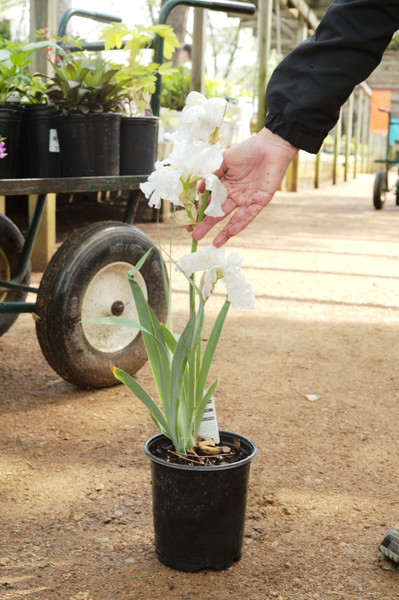Iris
Posted by Aaron Barton on May 16th 2021
Iris
Spring is in the air, with perennial gardens beginning to burst with color from both unusual plants and classic garden staples alike. Iris (eye-riss), of the Iris family, Iridaceae, are known for their striking and unusual flattened, sword-like fan of animal resistant leaves, offering a variety of species and appearances for nearly any space. Iris grow either from bulbs or from rhizomes, however all perennial varieties offered at Tonkadale are rhizomatous, including bearded, Siberian, northern blue flag, and sweet or zebra Iris.
Bearded Iris, Iris germanica (EYE-riss jerr-man-i-ka), also sometimes called common flag or German Iris, are native to southern Europe, though they have been widely naturalized in parts of the U.S. and Europe as well. Plants are known for their large ‘beards,’ which are the short, tufted, filament portion of the stamen of their flower. Bearded Iris prefer to be grown in full-sun, planted in well-drained, slightly acidic soil, blooming from mid-spring to late spring and maturing to around 24-36" tall and 18-24" wide. Bearded Iris are available in a wide variety of colors such as the lovely peach-colored blooms of ‘Peggy Sue’ or the striking orange and purple flowers of ‘Sharp-Dressed Man.’
Beardless Iris encompass a variety of Irises, including the noteworthy Iris sibirica (EYE-riss si-BIR-i-ka), or Siberian Iris. Siberian Iris, native to areas of central Europe and Asia, are robust plants, blooming from early spring to early summer and maturing to 18-24" tall and 12-18" wide. Siberian Iris generally prefer slightly acidic, moist, well-draining soil and full sun, but will tolerate short periods of drought as well. Siberian Iris provide an array of wonderful blooms for any garden, including the lovely blue blooms of ‘Bennerup Blue,’ and the soft yellow and purple blooms of 'Peacock Butterfly Uncorked.'
Northern blue flag Iris, Iris versicolor (EYE-riss verr-SIH-co-ler), is an excellent species native to wetlands of eastern North America including here in Minnesota. Reaching a mature size of 24-36" tall and 18-24" wide, northern blue flag Iris thrives in full or part sun in consistently moist or wet soils, even tolerating up to four inches of standing water. Blooming from late spring to early summer, northern blue flag Iris produces clusters of three to five blue-purple flowers with white and yellow accents, forming attractive colonies over time in water gardens, shoreline restorations, moist sunny borders, pollinator gardens, and rain gardens.
Japanese water Iris, Iris ensata (EYE-riss en-SA-tuh), are another excellent Iris for consistently moist or wet sites, native to China, Korea, Russia, and Japan, where they've been in cultivation for hundreds of years. Japanese water Iris thrive in moist sites in full or part sun, even tolerating up to six inches of standing water during the growing season. However, wet sites should be avoided late in the season, as plants are prone to rot when dormant if planted in standing water. Pots can either be sunk in the soil in wet sites and moved to drier areas in the fall, or plants can simply be planted in evenly moist soils without standing water. Maturing to a height of 24-36" tall and 18-24" wide and blooming from early summer to mid-summer, Iris ensata produce beautiful blue, purple, pink, or white blooms. Many popular cultivars are available including the deep purple blooms and variegated leaves of 'Variegata.'
Also sporting stunning variegated leaves, cultivars of the aptly named sweet or zebra Iris, Iris pallida (EYE-riss pal-i-duh), form fans of soft green and white striped leaves. Native to rocky regions of the eastern Mediterranean including northern Italy and Croatia, zebra Iris thrive in moist, well-drained soils in full or part sun. Plants mature to 24-36" tall and 18-24" wide and bloom some of the most fragrant of all Iris blooms, flowering in shades of soft blue and purple from late spring to early summer with a wonderful, sweet fragrance.
Whichever Iris you decide to welcome into your garden, don’t forget to give them the nutrients they need to keep blooming their best. Be sure to fertilize at planting, and again once they are bloomed out for the season, avoiding nitrogen-heavy fertilizers in favor of bloom-focused formulations. Divide plants in the early fall every three to five years to manage clumps and promote more abundant flowering. Cut leaf fans back to six inches tall and separate with one fan per rhizome division, allowing cut rhizomes to dry before replanting. Plant new plants or divisions with rhizomes partially exposed above the soil and water in well while they establish themselves.
Happy Planting!

